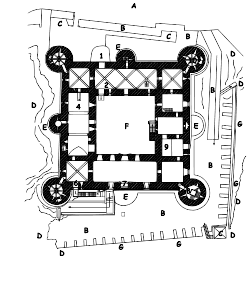Castello Ursino
| Ursino Castle | |
|---|---|
Castello Ursino | |
| Catania, Sicily, Italy | |
 View of the castle | |
 Plan of the castle's first floor | |
| Coordinates | 37°29′56″N 15°5′5″E / 37.49889°N 15.08472°E |
| Type | Castle |
| Site information | |
| Open to the public | Yes |
| Condition | Intact |
| Site history | |
| Built | 1239–1250 |
| In use | 13th–19th centuries |
| Events | Sicilian Vespers |
Castello Ursino (Template:Lang-scn), also known as Castello Svevo di Catania,[1] is a castle in Catania, Sicily, southern Italy. It was built in the 13th century as a royal castle of the Kingdom of Sicily, and is mostly known for its role in the Sicilian Vespers, when it became the seat of the Sicilian Parliament. The castle is in good condition today, and it is open to the public as a museum.
History
Construction
Castello Ursino was built between 1239 and 1250, as one of the royal castles of Emperor Frederick II, King of Sicily, closing a chapter on the turbulent time in Sicily that followed the death of his predessor, William II.[2] Local lords had attempted to assert independence, and in 1220 Frederick II had ordered the destruction of all non-royal castles in Sicily.[2] Castello Ursino was built to stress royal power as well as for the defence of the capital,[2] and was considered impregnable at the time.
Sicilian Vespers
In 1295, during the Sicilian Vespers, the Parliament which declared deposed James II of Aragon as King of Sicily, replacing him with Frederick III, was held here. The following year it was captured by Robert of Anjou but was later again in Aragonese hands.
Royal seat
King Frederick III resided in the castle, as well as his successors Peter II, Louis, Frederick IV and Maria. Here the latter was kidnapped by Guglielmo Raimondo III Moncada to avoid her marriage with Gian Galeazzo Visconti (1392). King Martin I held also his court in the castle.
Decline
After the move of the capital away from Catania and the appearance of powder weapons, the castle lost its military role and was used as a prison. It is one of the few buildings in Catania to have survived the earthquake of 1693.
When the castle was first built, it was on a cliff looking out to sea, however as the result of volcanic eruptions, and earthquakes, it is now a kilometre inland. The former moat too in the 17th century was filled with lava from an eruption by Mount Etna. Its present location, surrounded by streets and shops in a typical Catania piazza, may strike some visitors as unusual.
Present day
The castle was acquired by the city of Catania in 1932, and it was restored. The Museo civico opened in the restored castle on 20 October 1934. Today, the museum houses artifacts and artwork from the castle as well as the greater geographical area. These items date from the Classical era onward, representing the diverse influences throughout Sicilian history.[1]
Further restoration work was carried out in November 2009.
Layout
The castle has a rectangular plan, with a large circular tower at each corner and an open-air inner court
References
- ^ a b Orlando, Andrea. "Castello Ursino O Svevo Di Catania". iCastelli.it (in Italian). Retrieved 24 July 2015.
- ^ a b c Hindley, Geoffrey (1968). Castles of Europe. Great Buildings of the World. Feltham, Middlesex, England: Paul Hamlyn. p. 149. ISBN 978-0-600-01635-9.
